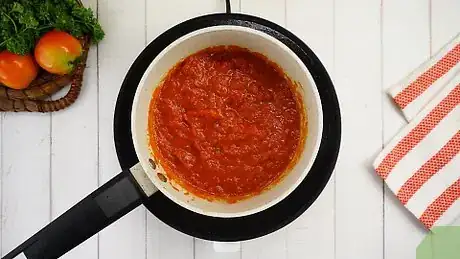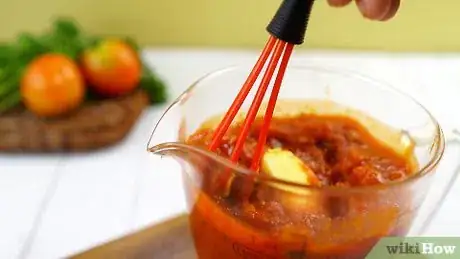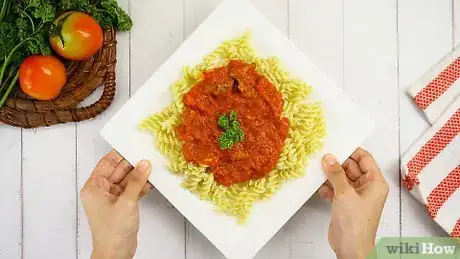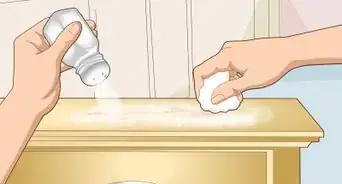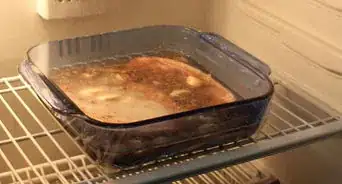This article was co-authored by wikiHow staff writer, Hannah Madden. Hannah Madden is a writer, editor, and artist currently living in Portland, Oregon. In 2018, she graduated from Portland State University with a B.S. in Environmental Studies. Hannah enjoys writing articles about conservation, sustainability, and eco-friendly products. When she isn’t writing, you can find Hannah working on hand embroidery projects and listening to music.
The wikiHow Video Team also followed the article's instructions and verified that they work.
This article has been viewed 8,940 times.
Learn more...
If you cook a lot, you may have stumbled upon recipes that call for you to reduce a sauce. Reducing a sauce simply means to place it over a heat source and let all the water and extra moisture evaporate. You can reduce sauce in about 30 minutes to make a thick and creamy topping for your dinner tonight.
Steps
Simmering the Sauce
-
1Put your sauce in a wide, deep pan, if you are in a hurry. Sauces reduce the fastest when the heat is spread out over a large area. Transfer your sauce into a pan that has tall sides and a wide bottom.[1]
- You can leave the sauce in the original pan if you aren’t on a time crunch.
- If you have a large batch of sauce that you want to reduce quickly, you can even split it into 2 large pans.
-
2Remove any chunks of meat from your pan. Use a serrated spoon to pick out the larger chunks of beer of poultry floating in your sauce. Set them aside to use later.[2]
- Large chunks of meat absorb a lot of heat and can make your sauce take longer to reduce.
Advertisement -
3Set your pan of sauce over medium heat for 15 to 30 minutes. Reducing a sauce takes time and patience. Keep your heat on medium high as your sauce thickens to let the water evaporate at a slow pace. Stir your sauce occasionally so that it doesn’t burn.[3]
- Your sauce may simmer, but turn down the heat if it starts to boil.
Warning: Turning the heat up too high could cause your sauce to burn.
-
4Keep your pan uncovered as the sauce reduces. A lid will only serve to trap in the steam and add more moisture back into your sauce. Leave your pan uncovered to give the water a place to go.[4]
- If you are worried about your sauce bubbling over without a lid, try using a larger pot or turning down the heat.
Measuring and Serving the Sauce
-
1Turn the heat off when your liquid is half gone. Check your recipe to see how much your sauce should have reduced. If it doesn’t specify, turn your heat off once about half of the liquid in your pan is gone.[5]
Tip: You can estimate how much sauce is gone by finding the ring of liquid on the sides of your pan to mark how much sauce you started with and compare it to how much you have now.
-
2Check the thickness of your sauce by dipping a spoon into it. Take the back of a spoon and dip it into your sauce. Swipe your finger across the sauce to create a stark line on the spoon. If the line holds up, your sauce is thick enough. If it doesn’t, you may need to reduce your sauce for a few more minutes.[6]
- This is especially true with cream-based sauces and gravies.
-
3Pour your sauce into a measuring cup for the most accurate reduction. If your recipe calls for a certain amount of reduced sauce, pour it into a measuring cup to see how much liquid you actually have left. Make sure you use a heat-proof measuring cup to avoid any cracking or shattering.[7]
- If you aren’t using your sauce in a recipe, you don’t need to double check it with a measuring cup.
-
4Whisk in 1 tbsp (15 g) of butter for extra thickness. If you are making a meat-based sauce or gravy, add some butter in before you serve it. This will make the sauce thicker as well as give it some extra shine.[8]
- If you are making a tomato-based sauce or a vinegar sauce, don’t add butter. It could make your sauce too creamy or change the flavor.
-
5Add your meat chunks back in to let them warm up. If you took out any large portions of meat, carefully add them back into your sauce. Keep your pan on low heat until the meat warms back up before you serve your dish to your guests.[9]
- You can also heat up the meat in the oven before you put it back in if you are worried about over-reducing your sauce.
-
6Serve your sauce warm with pasta or another main course. Since your sauce is so thick, if you wait for it to cool down, it could congeal or become lumpy. Pour your sauce over your meal as soon as it is thick enough for your friends and family to enjoy.[10]
- You can save your sauce in an airtight container and reheat it once if you’d like to save some.
Things You’ll Need
- Large saucepan
- Whisk (optional)
References
- ↑ https://www.bonappetit.com/test-kitchen/cooking-tips/article/how-to-make-a-reduction
- ↑ https://www.bonappetit.com/test-kitchen/cooking-tips/article/how-to-make-a-reduction
- ↑ https://www.foodrepublic.com/2011/05/16/how-to-make-a-reduction/
- ↑ https://www.bonappetit.com/test-kitchen/cooking-tips/article/how-to-make-a-reduction
- ↑ https://www.thekitchn.com/3-ways-to-know-when-your-sauce-has-reduced-226380
- ↑ https://www.bonappetit.com/test-kitchen/cooking-tips/article/how-to-make-a-reduction
- ↑ https://www.thekitchn.com/3-ways-to-know-when-your-sauce-has-reduced-226380
- ↑ https://www.bonappetit.com/test-kitchen/cooking-tips/article/how-to-make-a-reduction
- ↑ https://www.bonappetit.com/test-kitchen/cooking-tips/article/how-to-make-a-reduction

